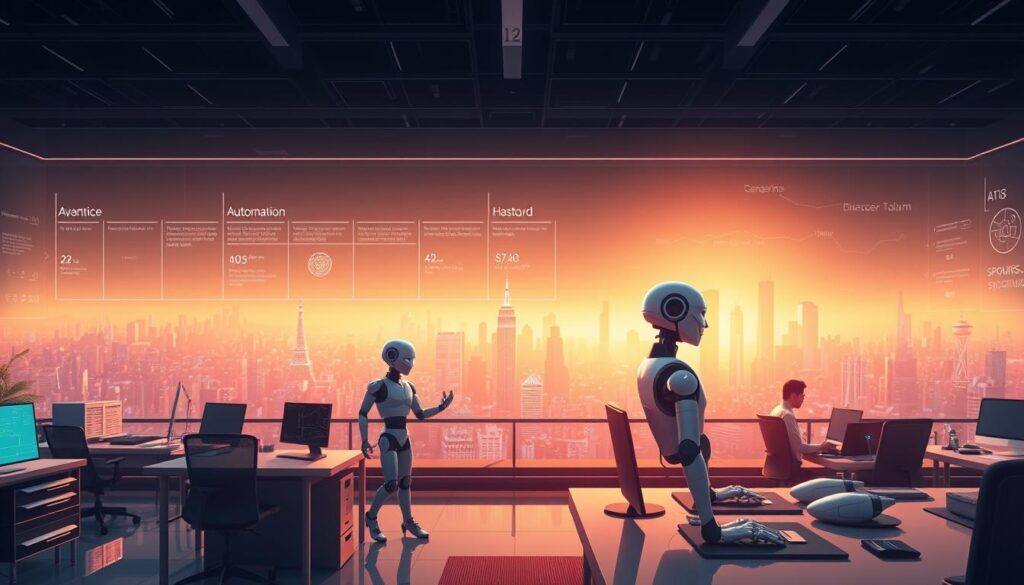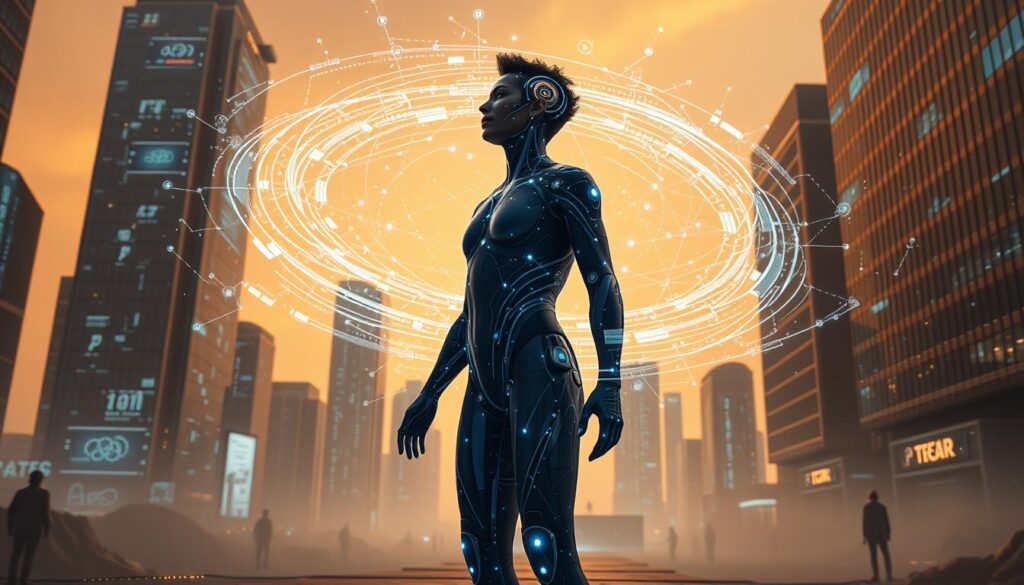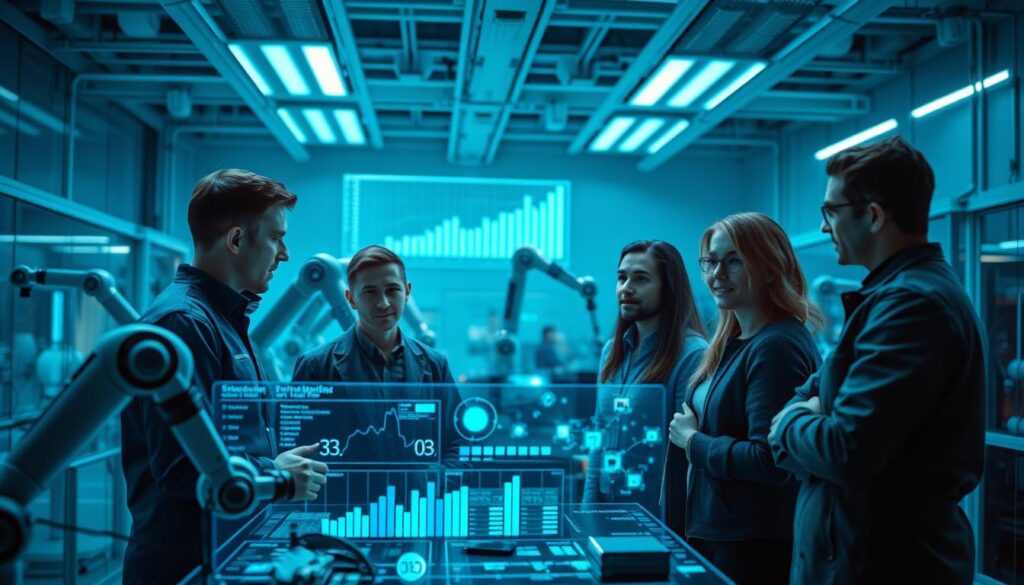“The future belongs to those who prepare for it today.” – Malcolm X. This quote captures the essence of the seismic shifts happening in the workforce due to technology. AI agents are not just tools; they are redefining how businesses operate and compete.
Organizations are witnessing a paradigm shift as AI-driven processes challenge traditional methods. From software development to customer service, AI agents are boosting productivity by over 50% and reducing cycle times by up to 60%1. This is not an incremental change but a transformation akin to the internet revolution.
Companies that fail to adopt AI at scale risk being left behind as nimble, AI-native competitors emerge1. The next 12 to 24 months will be critical for businesses to adapt and thrive in this new landscape.
Key Takeaways
- AI agents are transforming workflows, enhancing productivity, and reducing errors.
- Traditional employment models are being challenged by agile, AI-driven processes.
- Companies must adopt AI at scale to remain competitive.
- AI integration can lead to significant ROI for organizations that restructure their workforce.
- The future of work in the United States will be shaped by strategic AI adoption.
Understanding AI Agents: Definition and Capabilities

AI agents are reshaping industries by automating complex tasks and enhancing decision-making processes. These software entities operate autonomously or semi-autonomously, leveraging advanced technologies to perform specific functions. From analyzing vast datasets to detecting anomalies, they are transforming how businesses operate.
Definition and Key Features
An AI agent is a system designed to perform tasks without constant human intervention. It uses machine learning, natural language processing (NLP), and deep learning to adapt and solve problems creatively. For example, in healthcare, these agents analyze patient data to predict potential complications, reducing hospital readmission rates by approximately 20%2.
Key features include adaptability, workflow automation, and the ability to process information at speeds up to 100 times faster than human capabilities2. This makes them invaluable in sectors like finance, where they predict risks with an accuracy rate of 85%2.
Technologies Behind AI Agents
The foundation of AI agents lies in technologies like machine learning, NLP, and deep learning. These enable them to understand and generate human-like responses, making interactions more personalized. For instance, proactive AI monitoring in healthcare decreases readmission rates by allowing early detection of complications2.
Advancements in processing power and GPU acceleration have significantly contributed to their evolution. With the availability of massive training datasets, AI agents are becoming more sophisticated and accurate in real-life applications3.
The synergy between human expertise and AI tools creates augmented intelligence, enhancing decision-making processes and improving overall efficiency. Organizations that integrate these systems report a 30% improvement in decision accuracy2.
Historical Evolution of AI in Employment

The journey of artificial intelligence in the workforce began with humble origins but has grown into a transformative force. Early research by pioneers like Alan Turing and John McCarthy laid the groundwork for what would become a revolution in how businesses operate4.
In the mid-20th century, AI was a theoretical concept. By the 1970s, automation in manufacturing began reshaping industries, starting with the automobile sector4. This marked the first wave of AI’s impact on employment, as machines took over repetitive tasks.
Fast forward to the 21st century, and AI has evolved into sophisticated systems capable of complex decision-making. From predictive analytics to personalized customer interactions, these advancements have redefined organizational structures5.
Milestones in AI Development
The 1950s saw the birth of AI as a field of study. Turing’s famous question, “Can machines think?” sparked decades of innovation4. By the 1980s, expert systems emerged, enabling machines to mimic human decision-making in specific domains.
In the 1990s, machine learning algorithms gained traction, allowing systems to learn from data. This paved the way for modern AI agents, which process vast datasets in real-time5. Today, these agents are integral to industries like finance, healthcare, and retail.
“The future is already here—it’s just not evenly distributed.” – William Gibson. This quote captures the uneven adoption of AI across sectors. While some businesses thrive with AI integration, others struggle to adapt6.
Historical transitions, like the shift from agriculture to manufacturing, highlight how technology reshapes labor markets. AI’s evolution follows a similar pattern, with initial challenges giving way to long-term benefits4.
Today, AI agents are not just tools but partners in decision-making. They enhance efficiency, reduce costs, and improve customer experiences5. As organizations continue to embrace these technologies, the workforce will evolve, creating new opportunities and challenges.
AI Agents and Their Role in Business Transformation

The integration of AI agents is revolutionizing how companies streamline processes and save time. These tools automate routine tasks, allowing teams to focus on strategic initiatives. For example, PwC has partnered with retail and technology firms to implement AI solutions that reduce cycle times by up to 40%7.
Businesses are leveraging AI to enhance service quality and improve operational performance. Salesforce’s AgentForce, for instance, automates customer service tasks, boosting efficiency by 30%8. Similarly, HubSpot’s Breeze engine has transformed marketing processes, enabling faster campaign execution and better results.
AI agents also drive data-driven decision-making, reducing errors and improving accuracy. Companies using these tools report a 20% increase in productivity and a 15% reduction in operational costs7. This shift from traditional models to agile, AI-driven structures is critical for staying competitive in fast-paced industries.
Time savings are a significant benefit of AI adoption. By automating repetitive tasks, businesses can allocate resources more effectively. For example, AI-driven CRM systems have cut hiring time by 50%, allowing companies to scale quickly7.
In conclusion, AI agents are transforming business models by streamlining processes, enhancing service quality, and saving time. Companies that embrace these technologies will gain a competitive edge in the evolving market landscape.
The Impact of AI Agents on Traditional Employment Models

As industries evolve, AI agents are fundamentally altering job roles and workforce dynamics. These intelligent systems are automating routine tasks, reducing labor demands in areas like manufacturing and retail. For example, up to 70% of work hours in manufacturing could be automated by 20309. This shift is reshaping how organizations approach workforce planning.
While automation displaces some roles, it also creates new opportunities. Sectors like healthcare and education are expected to see a surge in demand for skilled professionals. AI could generate between 20 to 50 million new jobs globally by 2030, focusing on technology-driven fields9. This dual impact highlights the transformative power of these tools.
Managers are leveraging AI to monitor workflows and boost productivity. These tools provide real-time insights, enabling better decision-making and resource allocation. Companies using AI report a 30% increase in productivity and a 15% reduction in operational costs. This makes AI an essential component of modern management strategies.
However, human oversight remains critical. While AI drives efficiency, it requires guidance to ensure ethical and responsible use. Organizations must balance automation with strategic oversight to maximize benefits. This approach ensures that AI complements human expertise rather than replacing it entirely.
Employment models are undergoing significant changes. Traditional roles are being redefined, with a focus on flexibility and adaptability. For instance, 60% of work hours in finance could be automated, but new roles in AI oversight and training are emerging9. This evolution underscores the need for continuous learning and skill development.
In conclusion, AI agents are reshaping employment models by automating tasks, creating new roles, and enhancing management capabilities. Organizations that embrace these changes will thrive in the evolving workforce landscape.
Augmented Intelligence: Enhancing Human Capabilities

Augmented intelligence is reshaping how humans and machines collaborate in the workplace. Unlike traditional AI, which focuses on automation, augmented intelligence enhances human decision-making and creativity. This approach ensures that productivity and innovation thrive in modern workplaces10.
Collaboration between humans and AI delivers faster and smarter outcomes. For example, in healthcare, AI systems reduce error rates by up to 30%, allowing professionals to focus on complex cases11. Similarly, in finance, AI analyzes customer data to provide personalized services, minimizing manual errors10.
Strategic integration of AI is key to unlocking its full potential. Companies that adopt augmented intelligence report a 40% improvement in project completion times12. This highlights the importance of aligning AI tools with organizational goals to maximize efficiency.
Applications of augmented intelligence span multiple industries. In software development, AI accelerates prototyping by 50%, enabling faster innovation12. In customer service, AI handles routine inquiries, freeing human agents to tackle complex issues11. These examples demonstrate how AI complements human expertise.
Augmented intelligence bridges technical capabilities with creative human insight. By automating repetitive tasks, AI allows employees to focus on meaningful work, boosting engagement by 20%12. This synergy ensures that businesses remain competitive in a rapidly evolving landscape.
In conclusion, augmented intelligence is transforming workplaces by enhancing human capabilities. Organizations that embrace this strategy will achieve greater efficiency, innovation, and success.
Business Strategy in the Age of AI Disruption

Businesses are navigating a new era where AI reshapes strategies and operations. Traditional models are being replaced by agile, data-driven approaches. Companies that embrace this shift are gaining a competitive edge in their industry.
Automation is at the heart of this transformation. By automating repetitive tasks, companies reduce operational costs and improve service quality. For example, AI-powered tools have cut decision-making time by up to 50%13. This allows employees to focus on strategic initiatives.
Embracing Innovation for Competitive Advantage
Innovation is key to staying ahead. Firms that pioneer AI practices report a 30% increase in productivity14. By integrating AI into workflows, businesses streamline processes and enhance efficiency. For instance, AI-driven CRM systems have reduced hiring time by 50%13.
Companies are also restructuring their workforce to better align with AI technologies. This includes upskilling employees and creating roles focused on AI oversight. Such changes ensure seamless integration and maximize the benefits of automation.
Data-Driven Strategic Planning
Data is the foundation of modern strategy. AI tools analyze vast datasets to identify value pools and opportunities. Organizations using these insights report a 40% improvement in decision accuracy15. This approach enables smarter, faster planning.
Case studies highlight the impact of strategic AI adoption. A financial services firm achieved double-digit revenue growth by using AI for creditworthiness evaluation14. Similarly, companies leveraging AI for innovation see a 50% faster time-to-market for new products13.
In conclusion, AI disruption is reshaping business strategy. By embracing automation, fostering innovation, and leveraging data, companies can thrive in this evolving landscape. Those who adapt will lead their industry into the future.
Sector-Specific Impacts: Retail, Technology, Healthcare and More

From retail to healthcare, AI is reshaping operational landscapes in unprecedented ways. Each industry is leveraging these tools to enhance efficiency, streamline processes, and improve decision-making. The transformative power of AI is evident in the unique challenges and opportunities it presents across sectors.
Impact Examples by Industry
In retail, AI is revolutionizing inventory management. By analyzing consumer behavior, these systems predict demand accurately, reducing overstock and stockouts. Retailers using AI report a 20% improvement in inventory turnover16. This not only saves costs but also enhances customer satisfaction.
Technology companies are adopting AI-driven omnichannel contact centers. These systems handle customer inquiries seamlessly across platforms, improving response times by 30%17. This development ensures a consistent and efficient customer experience, boosting brand loyalty.
Healthcare is another sector benefiting from AI. Diagnostic systems powered by AI analyze medical data with precision, reducing diagnostic errors by 25%18. This analysis enables faster treatment decisions, improving patient outcomes and reducing costs.
Industries are experiencing varied transformations based on their ability to integrate AI. For example, financial services have seen a 14% productivity increase due to AI adoption16. Meanwhile, manufacturing has automated up to 70% of repetitive tasks, freeing workers for more strategic roles17.
Case studies highlight these impacts. A retail chain implemented AI for inventory management, cutting costs by 15% and improving stock accuracy18. A tech firm’s omnichannel system reduced customer wait times by 40%, enhancing satisfaction16. These examples underscore the sector-specific benefits of AI.
In conclusion, AI is driving significant changes across industries. By improving efficiency, enabling better analysis, and fostering development, these technologies are reshaping how businesses operate. Organizations that embrace AI will thrive in this evolving landscape.
Data-Driven Decision Making and Automation

Data-driven strategies powered by intelligent systems are transforming how businesses operate and make decisions. These tools analyze vast datasets to provide actionable insights, enabling organizations to optimize processes and reduce costs19.
One of the key benefits is the automation of repetitive tasks. By handling routine work, these systems free up human resources for more strategic activities. For example, administrative tasks can be automated by up to 50%, significantly lowering operational expenses20.
Real-time insights are another game-changer. AI systems process data at incredible speeds, allowing businesses to make informed decisions quickly. This capability improves forecasting precision by as much as 40%, ensuring better outcomes19.
Financial institutions have seen tangible benefits. AI-driven risk modeling has reduced operational hazards by 25%, while compliance infractions have dropped by 20%19. These metrics highlight the value of integrating intelligent systems into workflows.
The synergy between human judgment and machine processing is critical. While AI provides data-driven recommendations, human expertise ensures ethical and strategic alignment. This combination leads to high-quality decisions that drive business success20.
Operational work is also being redefined. By automating data-heavy tasks, organizations can allocate resources more effectively. This shift not only enhances efficiency but also improves employee satisfaction by focusing on meaningful work19.
For more on how AI is transforming business strategies, visit this resource.
Optimizing Workforce Productivity and Efficiency

Efficiency and productivity are at the core of modern business success, and intelligent systems are leading the charge. By automating repetitive tasks, these tools free up human resources for more strategic activities. For example, administrative tasks can be automated by up to 50%, significantly lowering operational expenses21.
Redefining roles within organizations is another key benefit. Routine tasks are streamlined, allowing employees to focus on complex and creative responsibilities. This shift not only enhances productivity but also improves the overall experience of the workforce22.
Improving employee experience is essential for retention and satisfaction. Efficient technology integration ensures that workers feel supported and valued. Companies deploying these systems report a 44% improvement in employee retention21.
Industry leaders like PwC have demonstrated the potential of these tools. By implementing intelligent systems, they reduced software development cycle times by 40%, enhancing both productivity and the work environment22.
Best practices include combining human skills with automation for operational excellence. This approach ensures that technology complements rather than replaces human expertise. For instance, AI-powered tools can analyze more information than a human can at one time, enhancing decision-making21.
In conclusion, optimizing workforce productivity and efficiency requires a strategic blend of automation and human insight. Organizations that embrace these tools will thrive in the evolving business landscape.
AI in Customer Engagement and Service Improvement

Customer engagement is evolving rapidly with the integration of advanced technologies. AI-driven contact centers are at the forefront of this transformation, offering seamless experiences across multiple channels. These systems, powered by tools like IBM Watson and Google Assistant, are redefining how businesses interact with their customers23.
Omnichannel Contact Center Innovations
Omnichannel solutions are enhancing customer experiences by providing consistent interactions across platforms. For instance, AI-powered virtual assistants handle inquiries in real-time, reducing wait times by up to 30%24. Predictive analytics further personalize these interactions, ensuring customers receive tailored responses based on their preferences.
Data-driven service models are optimizing delivery by analyzing vast datasets. This approach not only improves efficiency but also boosts customer satisfaction. Companies leveraging these technologies report a 20% increase in First Response Time and a 15% rise in Customer Satisfaction scores23.
Real-world examples highlight these advancements. A fast-growing bank in Asia doubled self-service channel use and reduced service interactions by 40-50% through AI integration23. Such transformations demonstrate the potential of intelligent systems in streamlining operations.
To maximize these benefits, staff must develop new skills. Training in AI collaboration ensures employees can effectively manage and enhance automated systems. This combination of human expertise and technology drives superior outcomes in the market.
In conclusion, AI is revolutionizing customer engagement by offering personalized, efficient, and consistent service. Businesses that adopt these innovations will lead in the competitive market landscape.
Legal, Ethical, and Regulatory Considerations in AI Integration

Navigating the complexities of AI integration requires addressing legal and ethical challenges head-on. Businesses must ensure compliance with evolving regulations while fostering transparency and fairness. For example, the California Consumer Privacy Act (CCPA) mandates annual cybersecurity audits for companies processing sensitive consumer data25.
Regulatory frameworks like GDPR emphasize transparency and consumer control. Organizations using Automated Decision-Making Technologies (ADMT) must provide pre-use notices detailing the purpose and potential outcomes of these systems25. This ensures that consumers are informed and can exercise their rights effectively.
Ethical considerations often drive change in AI deployment practices. Amazon’s recruiting tool, which was scrapped due to bias, serves as a cautionary example26. To mitigate such risks, businesses must implement protocols to ensure fairness and accountability. Regular risk assessments and updates are essential for high-stakes tasks like hiring and credit evaluations25.
Balancing innovation with legal responsibility is critical. The proposed CCPA regulations reflect a weighing test, where privacy risks are balanced against operational benefits25. This approach ensures that AI systems are deployed responsibly, minimizing harm to consumers.
Organizations must also address cybersecurity vulnerabilities. Regular audits help identify weaknesses in data storage and processing, reducing the risk of breaches25. By prioritizing ethical and legal considerations, businesses can build trust and ensure the responsible use of intelligence technologies.
In conclusion, integrating AI requires a proactive approach to legal, ethical, and regulatory challenges. By fostering transparency, mitigating bias, and ensuring compliance, organizations can navigate this complex landscape successfully.
Overcoming Challenges in AI Adoption and Legacy Systems

Adopting intelligent systems often comes with significant hurdles, especially when integrating with outdated infrastructure. Many organizations face difficulties in scaling these technologies, with over 90% struggling to align AI with existing systems27. These challenges can slow progress and limit the potential benefits of automation.
Integration Strategies and Continuous Improvement
Effective integration requires a strategic approach. Companies must modernize legacy systems to meet the demands of advanced technologies. High-performance computing resources, such as GPUs and TPUs, significantly improve efficiency and speed28. Cloud-based solutions offer flexibility, while on-premises setups require careful planning to manage costs.
Agile methodologies play a crucial role in this process. Continuous learning ensures that AI systems evolve with changing needs. For example, Snowflake’s architecture provides scalability and flexibility, enabling seamless data management29. This approach helps organizations stay competitive in a rapidly changing landscape.
Real-world examples highlight successful transitions. A financial services firm achieved double-digit revenue growth by integrating AI for creditworthiness evaluation28. Similarly, tech companies have reduced cycle times by 40% through intelligent automation27. These cases demonstrate the value of strategic planning and execution.
Training and cultural change are equally important. Upskilling the workforce ensures that employees can effectively manage and enhance automated systems. For instance, demand for technical skills like Process Mining has grown by 394%, reflecting the need for specialized expertise27. Companies that invest in training see higher retention rates and improved productivity.
Best practices from industry leaders emphasize balancing innovation with legacy challenges. Partnering with AI experts can streamline implementation and reduce risks28. By fostering a culture of adaptability, organizations can overcome barriers and unlock the full potential of intelligent systems.
For more insights on AI integration, explore this resource.
Future Trends: Economic Growth, Role Shifts, and Job Creation

Economic landscapes are shifting as intelligent systems redefine how industries operate and grow. These technologies are driving growth by enhancing productivity and creating new opportunities. For example, generative systems could generate $2.6 trillion to $4.4 trillion in value across industries30.
Role shifts are inevitable as automation transforms traditional job functions. Up to 80% of the U.S. workforce could see at least 10% of their tasks replaced by advanced systems31. However, this also opens doors for new roles in oversight, training, and innovation.
Job creation is a key outcome of this transformation. By 2030, global employment could see a net increase of 20 to 50 million jobs in technology-driven fields30. This highlights the dual impact of automation: displacing some roles while creating others.
Operational capability is improving across industries. Intelligent systems streamline processes, reduce errors, and enhance decision-making. For instance, predictive analytics have facilitated over $6 billion in capital investments30.
“The future of work is not about replacing humans but augmenting their abilities.” This quote underscores the importance of collaboration between humans and machines. By leveraging these tools, organizations can achieve greater efficiency and innovation.
Economic forecasts suggest significant growth opportunities. AI could raise national income by 5% to 14% by 2050, with a most likely scenario of an 11% boost32. This demonstrates the transformative potential of these technologies.
In conclusion, the future of work is being reshaped by intelligent systems. Organizations that embrace these changes will thrive in the evolving economic landscape, leveraging enhanced capability and operational efficiency to drive success.
Workforce Adaptation: Skill Development and Education
The rapid evolution of technology is reshaping workforce dynamics, creating a pressing need for skill development and education. As industries embrace automation, the demand for expertise in data science, programming, and critical thinking is surging33. This shift presents both opportunities and challenges for professionals and organizations alike.
Continuous learning is essential to bridge the skill gap. Educational boot camps and degree programs are emerging as effective solutions, equipping workers with the tools needed to thrive in a tech-driven economy34. For instance, retraining initiatives have shown job placement rates of up to 90%, highlighting the value of such programs33.
Investment in training is critical for preparing employees for new roles. Companies that prioritize upskilling report higher productivity and employee satisfaction34. For example, a logistics firm reduced operational costs by 20% after implementing a comprehensive reskilling program33.
Addressing the challenge of skill gaps is key to leveraging technology for competitive advantage. Industry leaders are taking proactive steps, such as partnering with educational institutions to design tailored curricula34. These efforts ensure that workers remain relevant in an evolving job market.
For more insights on how technology is transforming workforce dynamics, explore this resource.
In conclusion, workforce adaptation through skill development and education is essential in today’s fast-changing environment. By investing in training and embracing continuous learning, organizations can turn challenges into opportunities for growth and innovation.
Government Policies and Business Investment in AI
Government policies and business investments are driving the next wave of technological innovation. Strategic funding and regulatory frameworks are accelerating the adoption of advanced systems across industries. For instance, a $2 billion allocation for research in 2025 highlights the commitment to fostering innovation35.
One key benefit of these policies is the creation of a supportive ecosystem for development. By funding education and infrastructure, governments ensure that businesses have the resources needed to thrive. This approach not only boosts innovation but also ensures legal compliance36.
Businesses are also playing a pivotal role. Investments in automation and data-driven solutions are reshaping industries. Companies leveraging these technologies report a 30% increase in productivity, showcasing the tangible outcomes of strategic funding37.
Policy-driven success stories illustrate the power of collaboration. For example, public-private partnerships have enabled the development of robust cybersecurity measures, addressing vulnerabilities in systems35. Such initiatives ensure that innovation is both safe and effective.
The interconnected benefits of policy support and business initiatives are clear. By aligning goals, governments and companies can accelerate adoption while fostering a competitive landscape. This approach ensures long-term growth and innovation36.
In conclusion, the synergy between government policies and business investments is shaping the future of technology. With strategic funding and regulatory support, industries can achieve transformative outcomes, driving progress and competitiveness37.
Conclusion
Job landscapes are transforming as automation reshapes roles and creates new opportunities. While repetitive tasks face displacement, emerging roles like data scientists and AI trainers are on the rise38. This shift highlights the need for continuous learning and skill development to stay relevant.
From historical evolution to future trends, the balance between job loss and creation remains central. By 2030, up to 30% of global work activities could be automated, yet new opportunities in technology-driven fields are expected to grow39.
Strategic adaptation is key. Businesses must invest in training programs and restructure roles to emphasize innovation and strategy. This approach ensures sustained growth and competitive success in an evolving workforce.
Looking ahead, the future of work will be shaped by collaboration between humans and machines. Embracing change and fostering innovation will drive economic growth and redefine industries for years to come.
FAQ
What are AI agents and how do they function?
How have AI agents evolved in the workplace?
What industries are most affected by AI agents?
How do AI agents improve workforce productivity?
What challenges come with integrating AI agents into businesses?
What role do AI agents play in customer engagement?
How can businesses prepare for future AI trends?
What ethical considerations arise with AI agent usage?
How do AI agents contribute to economic growth?
What skills are essential for employees working with AI agents?
Source Links
- AI agents can reimagine the future of work, your workforce and workers
- Proactive AI Agents: Enhancing Efficiency and Addressing Ethical Concerns
- The AI Agent Revolution: Navigating the Future of Human-Machine Partnership
- The impact of AI on employment: a historical account of its evolution
- The AI Evolution- From Tools to Agents Revolutionizing Work
- Generative AI, the American worker, and the future of work
- Top 15 AI Agent Use Cases in Business
- The Rise of AI Agents: What Business Leaders Need to Know
- The Impact of AI on Future Employment Patterns
- Augmented Intelligence vs Artificial Intelligence | Know the Difference
- Beyond Artificial Intelligence: Embracing Augmented Intelligence for Modern Business – Pegasus One
- Embracing Augmented Intelligence: Enhancing Human Capabilities with AI
- AI in the workplace
- In the age of AI: Speed matters more, scale matters less, innovation matters most
- A.I. Is Going to Disrupt the Labor Market. It Doesn’t Have to Destroy It.
- Impact of AI on Workforce Productivity Statistics
- The Revolution of Data-Driven Decision-Making in 2025: The Role of AI Agents
- AI Agents Explained: The Future of Task Automation and Productivity
- AI in the Workplace | IBM
- The impact of artificial intelligence on employment: the role of virtual agglomeration – Humanities and Social Sciences Communications
- The next frontier of customer engagement: AI-enabled customer service
- The Impact of AI on Customer Engagement
- The Intersection of Agentic AI and Emerging Legal Frameworks
- Legal and Ethical Consideration in Artificial Intelligence in Healthcare: Who Takes Responsibility?
- AI Integration Challenges: Insights for Competitive Edge
- Overcoming AI Implementation Challenges in Enterprise Environments
- Enterprise AI and Legacy Systems: A Double-Edged Sword on the Path to Modernization
- Using AI in economic development: Challenges and opportunities
- No title found
- The Impact of AI on the Labour Market
- The Importance of Education and Workforce Development in the AI Era
- AI and the Workforce: Preparing for the Jobs of the Future | Thoughtful
- Generative AI and AI Agents: Transforming Business with Agentic AI
- Workforce ecosystems and AI
- Employer FAQs About AI Agents | JD Supra
- The Impact of AI on Traditional Job Roles: Adaptation and Skills Needed
- The Effect of AI Agents on the Job Market in 2025







